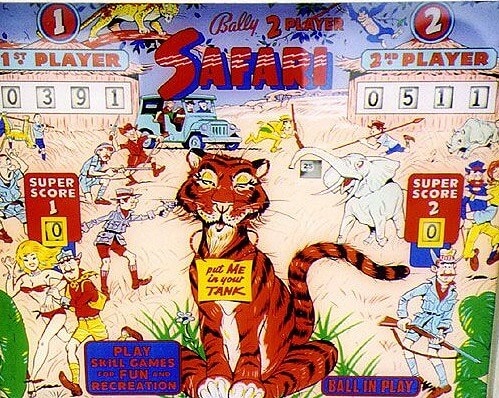


According to Cash Box Jul-27-1968 page 81, "The big news from Bally Mfg. Corp. this week is the release of "Safari," firm's first 2-player flipper since '66! Shipments are en route to Bally distributors across the country". The manufacturer produced the backglasses in both crystal glass and Plexiglas. The game in the manufacturer's flyer has a removable lockdown bar and a playfield glass that slides out, while the production games pictured in this listing all have the lift-up playfield glass in its metal frame. Additionally, the flyer game cabinet front is painted all one color with no green triangles, unlike the production games. We don't know if any production games had the slide-out glass or came from the factory without these green triangles. The flyer slogan was taken from one created in 1964 for Humble Oil, a division of Esso (now Exxon Mobil). Their catchphrase "Put a Tiger in your Tank" was very popular through the late 1960's to promote use of their gasoline in automobile gas tanks. Note the sign around the tiger's neck in the backglass. Pictured in this listing is the Add-a-Ball Relay Assembly used to convert a replay game to add-a-ball. We note the owner stated that he removed it from a Bally Safari in case it is not interchangeable with other Bally games. We have no further information on this assembly for Bally games but likely these assemblies were available to operators upon request. For this assembly to work as an operator option, a jack on the motor board would be installed by the factory and equipped with a shorting plug to provide replay operation. This plug would be removed by the operator so this relay assembly could be installed in a nearby vacant area on the motor board. We expect the operator would cover the replay window with a sticker provided for this purpose. The production game pictured here having serial number 1354 and credited to Mr. Bro�at is included to show that a pop bumper has been installed between the flippers in place of the passive bumper used on all other games. Under the playfield, a large coil assembly is seen for this pop bumper where a simple switch would otherwise be. Near the left flipper coil, an unidentified relay is present. The owner could not discern if this pop bumper was an after-factory modification and we could not receive higher resolution pictures as he had since parted with the game. The backglass is actual glass, not plexiglass as may be expected for export games. The optional Add-a-Ball Relay Assembly has been installed on the lower cabinet motor board. Both bells have been removed from the backbox, an operator preference in Germany we are told, however the owner stated he obtained the game from the Netherlands. See the Notes for Bally's 1969 'Cosmos' for more information about bell removal in European countries for games of this period. The production game pictured here having serial number 1971 and credited to Mr. Eppley does have both bells in the backbox. To the right of the three backbox connectors at bottom center is a small square of black protective paper that looks factory-stapled to the insert over where a light bulb socket is. A bulb is present in this socket. After comparing the games in this listing, it appears the use of the black paper insulation is not consistently used from game to game in the area of these connectors or behind the high-score adjustment jack. On the lower cabinet motor board, the optional Add-a-Ball Relay Assembly has not been installed and we can see two starter holes in the wood where it would be placed. The factory-provided shorting plug is installed in the jack where the Assembly would connect. Also pictured here are two Early Production games with serial numbers 1029 and 1098. Their score reels are yellow, not white like the other games. Inside the backbox, #1098 has a 6-position connector in the lower left corner that #1029 and later production games do not have. In the lower right corner of the backbox, #1029 has only five relays in the bank whereas #1098 has six relays and the left-most relay of the six is labeled 'Super Score Replay' while later production games label it with a different function as the 'Player-Up Alternator'. The lower cabinet motor board for each game was not cabled to have the jack for the Add-a-Ball Relay Assembly, leaving open space in this area. Nearby, in the open space halfway between where that Assembly would be mounted and where the Transformer is, in later production games exists the 'Tiger & Trail Reset Relay' but it is not cabled out on these two Early Production examples, or at least not at that physical location. On the front of the motor boards of both games, there is not an option jack for Add-A-Ball Mode nor one for 7-ball play even though their backglasses are silkscreened for up to 7 balls. Their coin doors were factory-equipped for three coin slots. #1098 was metered as a location test game because, in addition to the 'Total Play' meter, wired in was a '2 Can Play' meter, a 'High Score Replay' meter, and a 'Match' meter. The schematic diagram included with #1098 is in the Files section of this listing. It appears to be a regular production schematic which allows for Add-a-Ball operation but with handwritten changes in red pencil showing placement of these extra meters and the Super Score Relay. The handwriting also notes this Early Production game does not support Add-a-Ball operation or 7-ball play. #1029 is located in Sweden and has had its bells removed. If anyone has the Operator Instruction pages (the "manual") for this game, please contact us.
Loading leaderboard...